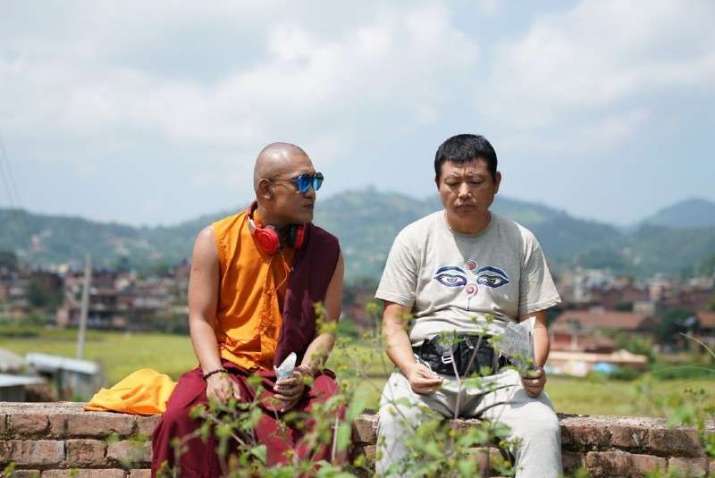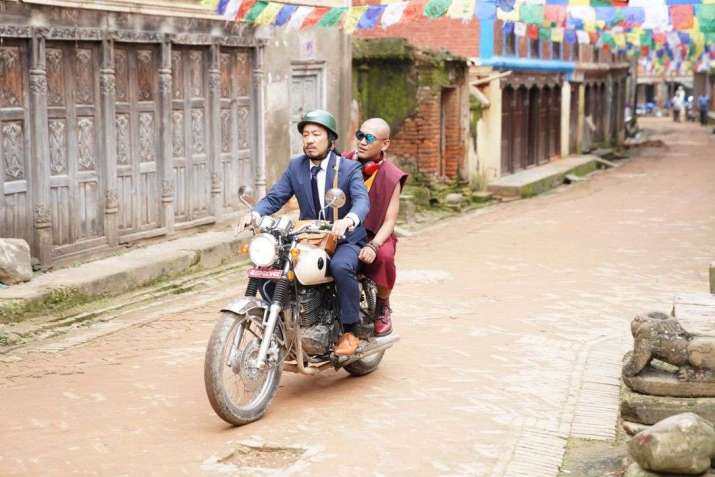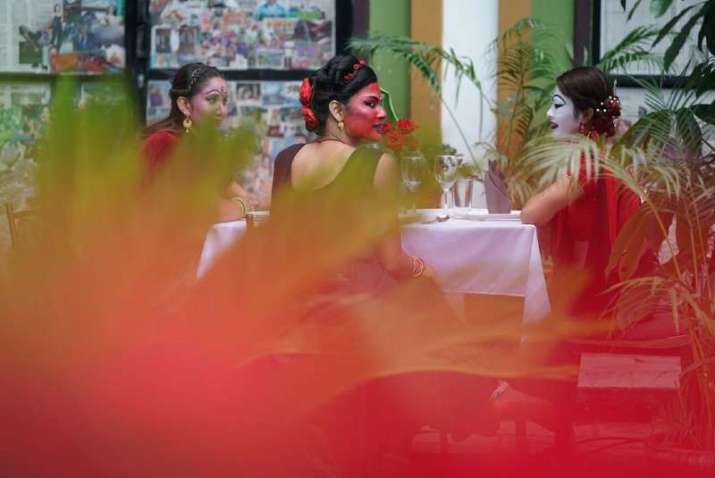FEATURES|COLUMNS|Coastline Meditations
Film Review: Khyentse Norbu’s Looking for a Lady with Fangs and a Moustache
 From lookingforalady.com
From lookingforalady.comWhen an entrepreneur is told he only has a week left to live, he reluctantly sets out on a mystical journey through the narrow streets of Kathmandu in search of his only salvation: the ephemeral dakini. A key figure in Vajrayana Buddhism, the dakini is a multifaceted being with mysterious spiritual power—a theme that is masterfully explored in Looking for a Lady with Fangs and a Moustache (2019), the newly released feature film by Tibetan-Bhutanese lama and filmmaker Dzongsar Jamyang Khyentse Rinpoche (b. 1961). As Khyentse Norbu states in the film’s press release:
[Dakini is an] inexpressible, unthinkable, unfathomable state. The only way to present it to the ordinary man, to ordinary people like us, we could only use language, we could only use symbols, so this is why you will notice that in the Himalayas there are so many representations of dakinis.
As Dzongsar Khyentse Rinpoche points out, the concept of dakini is incredibly difficult to understand let alone to depict, yet in his film he does a wonderful job at conveying these intricacies. Known in the film industry as Khyentse Norbu, the lama debuted as a consultant on Italian filmmaker Bernardo Bertolucci’s Little Buddha (1994), where he supervised the Tibetan monks to ensure that their performances were authentic. With five feature films now under his belt, it is evident that authenticity has remained a focal point of Khyentse Norbu’s process. A master at honing and depicting local stories and talents, his contribution to the development of the film industry in the Himalayan region is significant, and he intentionally stays clear of stereotypical film conventions. Looking for a Lady with Fangs and a Moustache follows suit. Khyentse Norbu tells us:
Though few films today escape the enormous influence of the Hollywood and Bollywood formulae, I want to explore in this film a distinctive Himalayan way of expression and storytelling that is true to this region’s culture, tradition and wisdom.
Khyentse Norbu took many calculated decisions to ensure that the film is evocative of the region it depicts. For example, he used only non-professional Nepalese actors. A wonderful consequence of this is that the characters feel incredibly genuine. Khyentse Norbu highlights that the film features “an actual highly respected spiritual master whose qualities and demeanor a hundred thousand trained actors could not fathom let alone convey.” Indicative of this desire to put forward content that is region specific and that goes beyond pure entertainment is the fact that the film premiered as part of the Rubin Museum’s brainwave series on 8 April 2021. In an online discussion that followed the viewing, Khyentse Norbu highlighted that devotion is an incredibly important aspect of Buddhism. Through his films, he tries to capture and portray the mystical dimensions of life that are integral to human existence but are sadly being eroded in the current age of imperialism and materialism.
 From lookingforalady.com
From lookingforalady.comAn exploration of the role of Tibetan mysticism in today’s post-modern world, the film focuses on the existential crisis of its protagonist Tenzin. Dubbed a “modern man” by the supporting characters, Tenzin perfectly illustrates the contrast between the old and the new. Having largely discarded his family’s special relationship with traditional Himalayan music, he is preoccupied with founding Kathmandu’s hippest coffee shop. While this secondary plot unfortunately serves as nothing more than an exposition tool—the relationship between Tenzin and his mother is feeble, and his search for a coffee shop is lacking in substantial conflict—the primary plot around Tenzin’s existential crisis is deeply engaging. When an oracle monk predicts that Tenzin’s dream of his diseased sister means impending doom, the protagonist is skeptical and this feeling is likely to be shared by the viewer. Although the oracle monk is adorned with a traditional Tibetan robe, he wears flashy sunglasses, a chunky set of headphones, and is constantly glued to his tablet in another signal of eroding values. Add to this a soundtrack that features quaint Himalayan music, together with internationally renowned music by the likes of Tom Waits, as well as shots of the general public, some of whom are wearing traditional garb while others wear office suits, and it becomes evident that Kathmandu is a real hodgepodge of the old and the new.
While Tenzin initially scorns the monk’s premonition, it becomes increasingly difficult to ignore the signs: his daily life is permeated not only with visions of his sister, but also of creatures with fangs and other fearsome apparitions. His other senses are also affected and he is particularly spooked by sudden and intermittent losses of hearing. Director of photography Mark Lee Ping Bing sets the tone beautifully by creating a dreamlike atmosphere that is engrossing and that helps the viewer to share the protagonist’s haunting feelings. Fantastical visions are superimposed on everyday sights, and this highlights the sense that, if one were to look close enough, one would discover that the mundane is always comprised of the magical. That said, the film features very fluid cinematography with subtle yet relentless movement. And while this helps to give the scenes their dreamlike quality, in some instances the choice is unmotivated and therefore dilutes the overall effect.
 From lookingforalady.com
From lookingforalady.comA visit to the doctor tells Tenzin that there is nothing wrong with him physically. It must therefore be depression, and modern-day healthcare’s one-stop solution for treating problems of the mind is to prescribe a dose of anti-depressants. This habit of providing immediate answers that ultimately numb the experiences of the soul is wonderfully contrasted with the very next scene, when a spiritual sage provides Tenzin with a completely different solution: he must find a dakini. But how and where does one look for a dakini? This time, there are no easy magic pills to swallow and no suggestion that Tenzin medicate and numb his uncomfortable mindset. Instead, he is encouraged to explore the signs, to think for himself, and to be creative. Whether it be in his own breath, in the water he drinks, or by singing in a crowd, Tenzin will only be saved if he allows himself to be truly alive. “You need to be bold. Dakinis don’t trust people with inhibitions,” the sage tells him.
The approach is very Buddhist: it is about a mindset rather than a fixed outcome. When Tenzin begins to doubt that a potential candidate is in fact a dakini, the sage reprimands him: “You’ve ruined it by thinking it’s not her. That’s called wrong view.” It is no secret that dakini can be a fleeting concept. As Khyentse Norbu explains, a dakini is nothing and everything simultaneously. Through its protagonist, Looking for a Lady with Fangs and a Moustache encourages the viewer to be curious about the dakini and, ultimately, the mystical: is the tea girl dakini? Is Tenzin’s friend Kunsel dakini? Is dakini a stranger? Is Tenzin dakini? Am I dakini? This spectacular journey, together with the dreamlike visuals and carefully chosen music, has the potential to inspire a sense of devotion in the viewer that will linger for days.
See more
Press Kit (Looking for a Lady with Fangs and a Moustache)
Looking For A Lady With Fangs And A Moustache Film Premiere And Director’s Conversation (Rubin Museum)
Related features from Buddhistdoor Global
Being a Rinpoche: A Conversation with Dzongsar Jamyang Khyentse Rinpoche
Buddhist-Influenced Filmmaking in an Extraordinary Time: An Interview with Gaetano Maida
On Being Brave: Dzongsar Khyentse Rinpoche on Technology and the Dissemination of the Dharma
Carving the Divine: The Vocation of Japanese Buddhist Woodcarving
A Buddhist Vision for Education Reform: The Blue Lion Preschool, Inspired by Dzongsar Khyentse Rinpoche
Bhikkhunī – Buddhism, Sri Lanka, Revolution: A Film on the Epicenter of Theravada Female Ordinations
The Dakini at the Bus Stop














